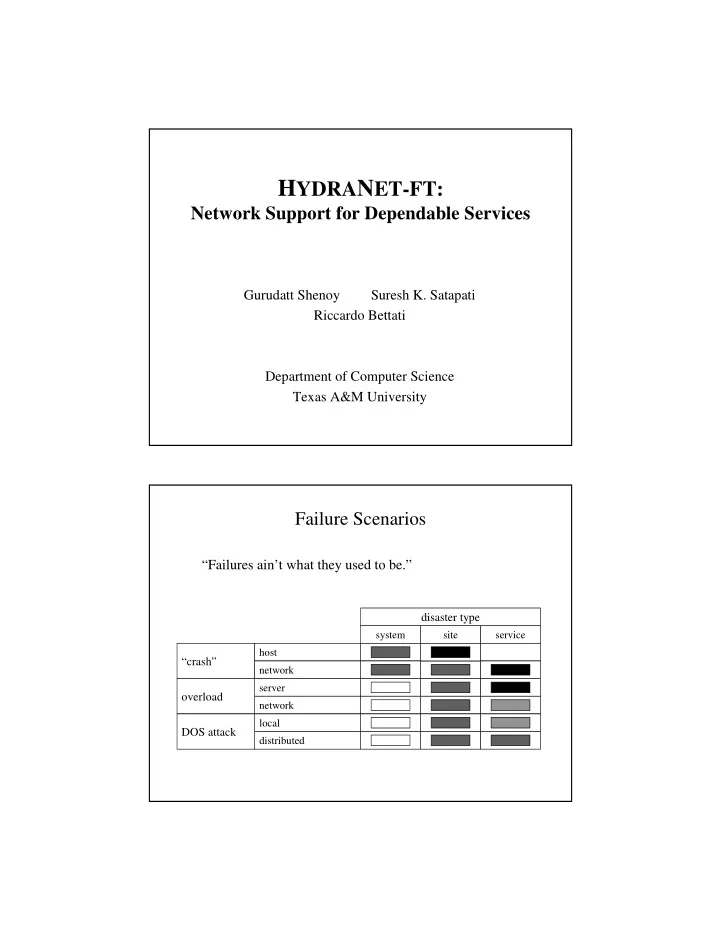

H YDRA N ET-FT: Network Support for Dependable Services Gurudatt Shenoy Suresh K. Satapati Riccardo Bettati Department of Computer Science Texas A&M University Failure Scenarios “Failures ain’t what they used to be.” disaster type system site service host “crash” network server overload network local DOS attack distributed
Good Solutions to Support Highly Tolerant Services... Programmatic Requirements … provide service replication across geographically distributed server hosts. … can be deployed and recalled on demand. … preserve server control over data. … support any service. … can be incrementally deployed. … remain fully transparent to clients. both mechanisms and recovery! Tolerance Requirements … support atomic multicast. … ensure message ordering. … provide low-latency failure detection mechanisms. The H YDRA N ET Approach to Redirection/Replication service replica server host clients service service host server • Bring services near to clients. redirector • Operate replicas under server’s control and identity.
Mechanisms for Redirection redirector http telnet “get from A” 80 25 128.194.132.34 “telnet to A” “get from A” origin host Origin IP Port Redirect IP http mail 128.194.132.34 80 128.101.134.1 80 25 128.101.133.12 25 128.101.134.1 host 128.101.134.1 server Performance Gains through H YDRA W EB Replication Access latencies for 1kB HTTP objects. gin 2 tiramisu (direct) (98/05/29 11:50am ) gin 2 tiramisu (half cache) (98/05/28 4:20pm) 1000 1000 100 frequency 100 frequency 10 10 1 1 1 501 1001 1501 2001 2501 1 501 1001 1501 2001 2501 latency (msec) latency (msec) H YDRA W EB Replication No Replication Origin host: berkeley.edu Origin host: berkeley.edu Client host: tamu.edu Client host: tamu.edu Host server: tamu.edu
The H YDRA N ET- FT Approach to Support of Highly-Tolerant Services The H YDRA N ET- FT Approach to Support of Highly-Tolerant Services
The H YDRA N ET- FT Approach to Support of Highly-Tolerant Services H YDRA N ET -FT: Supporting Tolerant Services through Fault-Tolerant TCP • Synchronization paradigm • Atomicity • Message ordering • Low-latency error detection • Virtual synchrony
H YDRA N ET -FT: Mechanisms replicated application socket buffer host client TCP machinery H YDRA N ET -FT: Mechanisms Synchronization at Socket Buffer Layer client
H YDRA N ET -FT: Mechanisms Atomicity through Acknowledgement Channel data-stream ACK-stream client H YDRA N ET -FT: Mechanisms Atomicity through Acknowledgement Channel ACK-channel tcp tcp tcp core core core data-stream ACK-stream client
H YDRA N ET -FT: Mechanisms Message Ordering: • Source ordering enforced by TCP. • Total ordering across connections enforced by ordered delivery on acknowledgement channel. tcp tcp tcp core core core client H YDRA N ET -FT: Mechanisms Failure detection provided by TCP re-transmission at client. tcp tcp tcp core core core ! client
Implementation • FreeBSD 3.1 • Modifications – Process control – IP forwarding – TCP machinery • Additional control system calls int v_host(u_long ip_address); int setportopt(port, mode, detector_parameters) Performance Measurements Comparison of Various Schemes 600 500 Throughput (KBps) 400 300 200 100 0 16 32 64 128 256 512 1024 Packet Size (* 1000 Byte) FT-old Scheme 1 Scheme 2 Scheme 3 Scheme 4 Clean Primary Only Redirection (no FT)
Demonstration: Real time Video Streaming File Type: Mpeg (5 MB) Frame Rate: 30.2 fps # Frames: 1509 Player: mTv (for FreeBSD) Client Host: Dell Inspiron (PII) Server Host(s): Intel PI 120 MHz Router: Intel 486/DX Network: 10 MBps Ethernet Infrastructure: HydraNet-FT Topology Movie Servers FT-TCP ACKChannel Redirector Client (Movie Player) FT-TCP Conclusion • Summary – Starting point: Traditional support for tolerance allocated either too high or too low in protocol stacks to allow for easy deployment on a large scale. – H YDRA N ET -FT – Satisfy declared requirements – Very-low latency recovery (client invisible) – Transparent on server side. • Outlook – Integrated control interface for server management – Demonstration of behavior for time-critical applications (video streaming) – Support for server camouflaging (hiding servers by geographically spreading profile)
Recommend
More recommend